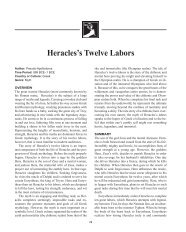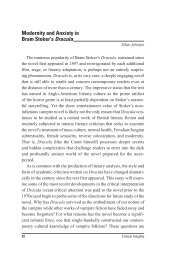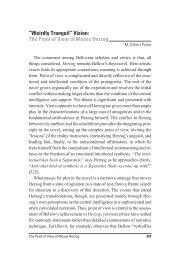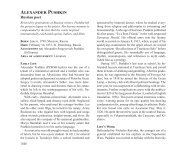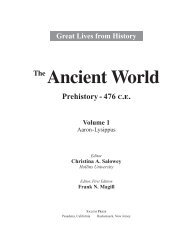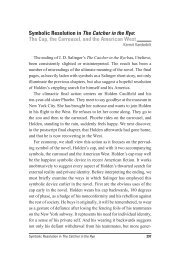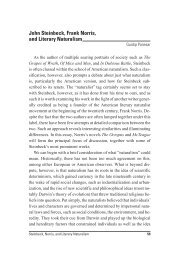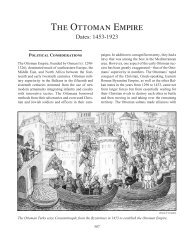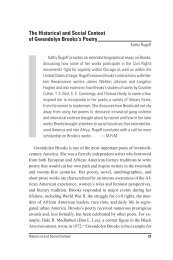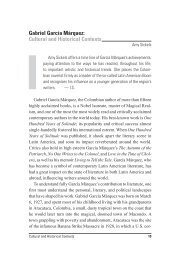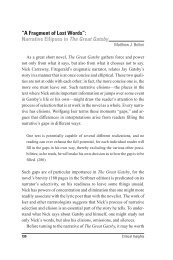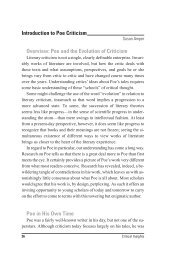Truman Capote - Salem Press
Truman Capote - Salem Press
Truman Capote - Salem Press
You also want an ePaper? Increase the reach of your titles
YUMPU automatically turns print PDFs into web optimized ePapers that Google loves.
Library of Congress<br />
Biography<br />
<strong>Truman</strong> <strong>Capote</strong> was born <strong>Truman</strong> Streckfus<br />
Persons, the only child of J. Archulus Persons and<br />
Lillie Mae Faulk Persons. During the first six years<br />
of his childhood, the boy frequently was handed<br />
off to the care of relatives by his carefree and irresponsible<br />
parents. Following his parents’ permanent<br />
separation when <strong>Truman</strong> was six, he was left<br />
fully in the care of relatives in Monroeville, Alabama.<br />
Being raised by a series of relatives, <strong>Capote</strong> had a<br />
lonely childhood existence; the experience forced<br />
him, as he said in many interviews as an adult, to<br />
create his own world, personality, and sense of<br />
identity. The search for that sense of selfhood was<br />
to be a frequent theme in his literary work, both fiction<br />
and nonfiction. One imaginative influence on<br />
the young <strong>Capote</strong> was his eccentric cousin Sook<br />
Faulk, who encouraged the boy’s propensity for<br />
fantasy invention. He was later to recall Sook as<br />
the doting parent surrogate in his short story “A<br />
Christmas Memory.”<br />
<strong>Capote</strong>’s childhood days can be seen in the<br />
novel To Kill a Mockingbird (1960), written by his<br />
childhood friend Harper Lee, in which the youthful<br />
<strong>Capote</strong> appears as the character Dill. Following<br />
his parents’ divorce in 1931, <strong>Capote</strong> spent most of<br />
his time in Monroeville until his mother was remarried<br />
in 1932 to Joseph <strong>Capote</strong>. Following their mar-<br />
<strong>Truman</strong> <strong>Capote</strong><br />
Born: New Orleans, Louisiana<br />
September 30, 1924<br />
Died: Los Angeles, California<br />
August 25, 1984<br />
<strong>Capote</strong>’s greatest accomplishment was his merging of the dramatic<br />
narrative techniques of fiction with the objective reportage<br />
of journalism in what he termed “the nonfiction novel.”<br />
riage, the boy was to change his name legally to <strong>Capote</strong><br />
and eventually move to New York to live with<br />
his mother and stepfather.<br />
<strong>Capote</strong> attended private schools in Manhattan<br />
and ultimately graduated from the Franklin School,<br />
although his attendance had been, at best, irregular.<br />
The boy’s time in an exciting metropolitan New<br />
York environment came at an impressionable age,<br />
and <strong>Capote</strong>, like one of his later heroines, Holly<br />
Golightly in Breakfast at Tiffany’s (1958), loved the<br />
pace, sophistication, and glamour of New York.<br />
<strong>Capote</strong>’s childhood fascination with words continued<br />
in his teenage years as he served as a<br />
copyboy and file clerk at The New Yorker magazine.<br />
Although none of <strong>Capote</strong>’s early work in fiction<br />
was published by The New Yorker, in 1945, the twentyone-year-old<br />
writer published several short stories<br />
that gained for him almost instant literary attention:<br />
“Miriam,” which appeared in Mademoiselle<br />
magazine; “A Tree of Night,” in Harper’s Bazaar;<br />
and “My Side of the Matter,” in Story magazine. The<br />
appearance of these stories, and the subsequent<br />
publication in 1948 at age twenty-three of his first<br />
novel, Other Voices, Other Rooms, achieved for the<br />
young writer overnight international acclaim.<br />
<strong>Capote</strong> often described the novel as a poetic version<br />
of his own lonely childhood—sensitive, abandoned,<br />
and isolated. The book was, he said, an<br />
emotional, or spiritual, autobiography, if not an actual<br />
literal one. The novel’s romanticized treatment<br />
of a homosexual theme made it a sensation in<br />
the late 1940’s, when only one other contemporary<br />
novel, Gore Vidal’s The City and the Pillar (1948),<br />
had dealt with homosexuality. The controversy<br />
397
<strong>Truman</strong> <strong>Capote</strong><br />
over <strong>Capote</strong>’s book was further intensified by the<br />
now-famous picture of the youthful author on its<br />
back cover sprawled seductively on a chaise longue<br />
with his blond bangs hanging over his elfin face.<br />
<strong>Capote</strong> quickly added to his reputation as a master<br />
of prose style with his 1949 short-story collection A<br />
Tree of Night, and Other Stories and the 1951 novella<br />
The Grass Harp.<br />
In the 1950’s, <strong>Capote</strong> began to explore a variety<br />
of journalistic approaches to writing, including the<br />
travel recollection of Local Color (1950), an extended<br />
account of an American opera company’s<br />
tour of the Soviet Union in The Muses Are Heard<br />
(1956), and his 1959 volume of commentary accompanying<br />
the photographs of Richard Avedon,<br />
Observations. In 1958, he produced his successful<br />
novella Breakfast at Tiffany’s, which further enhanced<br />
his reputation as a fiction writer. An equally<br />
popular film version of the novella followed in<br />
1961.<br />
In the 1950’s and 1960’s, <strong>Capote</strong> applied his talents<br />
to other literary forms, adapting two of his<br />
works for the theater—his novella, The Grass Harp,<br />
and later his short work House of Flowers, which was<br />
made into a musical. He also wrote two screenplays<br />
for films, Beat the Devil (1953) and a film version of<br />
Henry James’s gothic novella The Turn of the Screw<br />
(1898), released under the title The Innocents<br />
(1961). During the 1960’s, <strong>Capote</strong> also published<br />
the first two parts of what was to be a trilogy of emotionally<br />
etched stories of his childhood in the<br />
South: A Christmas Memory appeared in 1966 (it had<br />
originally been printed in Mademoiselle in 1956),<br />
followed by The Thanksgiving Visitor in 1967. A year<br />
before his death, a third volume, One Christmas<br />
(1983), was published, dealing with the visit of a<br />
boy to see his father, separated from him by divorce.<br />
<strong>Capote</strong>’s major achievement in the 1960’s, however,<br />
was to be the 1966 nonfiction book In Cold<br />
Blood: A True Account of a Multiple Murder and Its Consequences.<br />
This work, which describes the murder of<br />
the Clutter farm family in Kansas, required six<br />
years of research by the author. Many critics view In<br />
Cold Blood as <strong>Capote</strong>’s finest work; the author maintained<br />
that he had created a new art form, the<br />
“nonfiction novel.” This new form combined the<br />
detached observation of journalistic reportage<br />
with the dramatic story-telling techniques of fiction.<br />
<strong>Capote</strong> spent years in Kansas after the crime<br />
398<br />
was committed and, upon the capture of the two<br />
men charged with the killings, more time investigating<br />
the lives and motives of the killers right up to<br />
the time of their execution. The publication of In<br />
Cold Blood, first in installments in The New Yorker and<br />
later as a book, made <strong>Capote</strong> wealthy and gave him<br />
unparalleled celebrity as an author.<br />
Following the success of In Cold Blood, <strong>Capote</strong><br />
announced that the next literary project he would<br />
undertake was to be a roman à clef about New York<br />
and the international jet set with which he personally<br />
had become so familiar. Its title was to be Answered<br />
Prayers, and when completed, <strong>Capote</strong> predicted,<br />
the work would rival the achievement of<br />
French novelist Marcel Proust’s monumental Àla<br />
recherche du temps perdu (1913-1927; Remembrance of<br />
Things Past, 1922-1931), a claim <strong>Capote</strong> made repeatedly<br />
in television talk show appearances.<br />
His personal life and physical well-being, however,<br />
became increasingly chaotic during the<br />
1970’s. He wrote in a personal reminiscence, an interview<br />
with himself in his 1980 volume, Music for<br />
Chameleons: “I’m an alcoholic. I’m a drug addict.<br />
I’m homosexual. I’m a genius.” The complications<br />
from all those conditions simultaneously caused<br />
erratic behavior by the writer in his last decade and<br />
greatly diminished his writing volume, which had<br />
never been great because of his insistence on perfection<br />
of style.<br />
In 1973, he had published a collection of short<br />
pieces, The Dogs Bark: Public People and Private Places.<br />
Music for Chameleons included not only more personal<br />
profiles but also a new short account of another<br />
true crime, “Handcarved Coffins,” a kind of<br />
In Cold Blood in miniature. In 1983, the third of his<br />
childhood recollections appeared, a slender story<br />
in book form, One Christmas.<br />
Only four portions of Answered Prayers ever appeared.<br />
These four parts ran in 1975 and 1976 in<br />
Esquire magazine, and their appearance created a<br />
personal disaster for the writer, as many of the<br />
thinly disguised portraits of his friends grievously<br />
offended their models. Many of the writer’s<br />
wealthy friends simply cut all contact with <strong>Capote</strong>.<br />
In his last years, <strong>Capote</strong> was subject to frequent<br />
bouts with and recuperations from his many substance<br />
dependencies. He died in 1984, shortly before<br />
his sixtieth birthday, while on a visit to Los Angeles.<br />
Following <strong>Capote</strong>’s death, an extensive<br />
search was made for the missing portions of An-
swered Prayers, those segments the author so often<br />
said that he had completed. No portions of the<br />
work—other than those already published in magazine<br />
installments—were ever found. Some believe<br />
that <strong>Capote</strong> did write the complete book and destroyed<br />
the remaining sections. Others think the<br />
missing portions may exist somewhere, but the majority<br />
opinion holds that <strong>Capote</strong> never really wrote<br />
the rest of what he had promised would be his most<br />
revealing, most stylistically controlled work. The<br />
known segments were published after his death under<br />
the title Answered Prayers: The Unfinished Novel in<br />
1986.<br />
Analysis<br />
In the preface to the last collection of his work<br />
published in his lifetime, the 1980 volume Music for<br />
Chameleons, <strong>Capote</strong> discussed in detail his views<br />
about the ordeal of writing as a creative activity and<br />
his own lifetime commitment to that pursuit. Writing<br />
was an occupation with a great risk to it: One<br />
had to take chances or fail. Indeed, <strong>Capote</strong> compared<br />
writing to professional pool playing and to a<br />
professional card dealer’s abilities. He also explained<br />
that he began writing as a child of eight<br />
and was, by his view, an accomplished writer at seventeen.<br />
Thus, when Other Voices, Other Rooms appeared<br />
in 1948, he viewed it as the end result of<br />
fourteen years of writing experience.<br />
The substance of writing—and its accompanying<br />
pain of creation—<strong>Capote</strong> explained with a<br />
phrase he borrowed from Henry James; it was the<br />
“madness of art.” All imaginative writing was, he explained,<br />
the artist employing his creative powers of<br />
observation, of description, of telling detail; it was<br />
that act that led <strong>Capote</strong> in his later writing to see<br />
the possibilities of journalism (which is factual, detailed<br />
observation of truth) as an art form that<br />
could be as powerful as fictional writing. So it was<br />
that he shifted from fiction to nonfiction in midcareer<br />
with works such as The Muses Are Heard and<br />
his most famous work, In Cold Blood.<br />
For <strong>Capote</strong>, the writer is, by nature, an outsider,<br />
the observer seeing and hearing that which is<br />
about him but comprehending the witnessed<br />
events with an artistic sensitivity unknown to others.<br />
The outsider’s perspective is—simply because<br />
it is detached from the observed society—more<br />
comprehensive. As he was an artist “outside,” it was<br />
natural that <strong>Capote</strong>’s works often dealt with the<br />
<strong>Truman</strong> <strong>Capote</strong><br />
conflict between vulnerable persons similarly outside<br />
their more conventional environment. This<br />
theme can be seen in a number of his works, such<br />
as Other Voices, Other Rooms, and even in the real-life<br />
killer of his masterwork, In Cold Blood. Often this<br />
theme is played out in his work through a confrontation<br />
of an unconventional outsider with the conforming,<br />
ordered world.<br />
In Other Voices, Other Rooms, Cousin Randolph,<br />
the homosexual older relative, states the outsider’s<br />
lament as he attempts to explain the search for love<br />
to the youthful Joel, explaining that all men are isolated<br />
from one another, that everyone, in the end,<br />
is alone:<br />
Any love is natural and beautiful that lies within a<br />
person’s nature; only hypocrites would hold a man<br />
responsible for what he loves, emotional illiterates<br />
and those of righteous envy, who, in their agitated<br />
concern, mistake so frequently the arrow pointing<br />
to heaven for the one that leads to hell.<br />
A similar idea occurs in The Grass Harp when Judge<br />
Cool, having joined a rebellious group hiding in a<br />
tree house, speaks of those who are pagans or spirits<br />
and defines them as accepters of life, because<br />
they are those who grant life’s differences.<br />
Some of the more flamboyant examples of the<br />
free, nonconforming spirit are seen in <strong>Capote</strong>’s female<br />
characters, specifically Idabel, the tomboy<br />
twin of Other Voices, Other Rooms, who outwrestles<br />
young Joel in one scene and whose lack of femininity<br />
is an obvious counterpoint to Joel’s boyhood homosexual<br />
longings. Another such unconventional<br />
personality is Holly Golightly of Breakfast at Tiffany’s,<br />
who has run away from her background of<br />
poverty and also from a childhood marriage to<br />
seek glamor and to indulge her New York encounters<br />
with a series of wealthy men. Holly’s defiance<br />
of convention is as meaningful as Joel’s and<br />
Idabel’s or, for that matter, the runaways in The<br />
Grass Harp, whose tree house retreat is <strong>Capote</strong>’s<br />
symbol for all places of security for those who may<br />
be yearning for a place for their differences, their<br />
individual spirits, their ideal fantasies to be at<br />
home.<br />
<strong>Capote</strong> frequently said in interviews that he saw<br />
in the real-life killers—particularly Perry Smith—<br />
of In Cold Blood the man he might have become had<br />
his own life taken a different turn. His realization<br />
399
<strong>Truman</strong> <strong>Capote</strong><br />
was that the killers were the evil side of the same<br />
yearning for love, acceptance, even artistic achievement<br />
(especially with Smith) that he had known.<br />
That desire is seen in a key scene in Miami after the<br />
murders, as Perry realizes that all his hopes and<br />
ambitions are a dead end:<br />
Anyway, he couldn’t see that he had “a lot to live<br />
for.” Hot islands and buried gold, diving deep<br />
in fire-blue seas toward sunken treasure—such<br />
dreams were gone. Gone, too, was “Perry O’Parsons,”<br />
the name invented for the singing sensation<br />
of stage and screen that he’d half-seriously hoped<br />
some day to be.<br />
In <strong>Capote</strong>’s musical, House of Flowers, one of the<br />
characters sings a song of yearning for escape from<br />
the everyday titled “I Never Has Seen Snow,” and<br />
snow is a recurring image in many <strong>Capote</strong> works<br />
for the elusive dreams of life. One of the young boyfriends<br />
of the Clutter girl recalls becoming lost in a<br />
snowstorm in In Cold Blood. The cook, Missouri,<br />
hopes to run away north to see snow in Other Voices,<br />
Other Rooms. Judge Cool’s distant wife had died in<br />
the snows of Switzerland in The Grass Harp. Ultimately,<br />
in a world that fails to understand or make<br />
room for the sensitive, artistic spirits, the “different,”<br />
<strong>Capote</strong> returns frequently to the idea, stated<br />
by Judge Cool, that whatever passions compose<br />
them, private worlds are good—that is, unless<br />
turned to evil ends by the greater uncomprehending<br />
world.<br />
Other Voices, Other Rooms<br />
First published: 1948<br />
Type of work: Novel<br />
A young boy, seeking his lost father, moves into<br />
a strange household in Mississippi where he<br />
encounters bizarre relatives while trying to find<br />
love.<br />
Other Voices, Other Rooms, <strong>Capote</strong>’s first published<br />
long work, is a moody and atmospheric tale characterized<br />
both by its strange setting—a decaying<br />
mansion in rural Mississippi—and by the host of<br />
peculiar characters it presents to the reader.<br />
The book details the encounters of thirteen-<br />
400<br />
year-old Joel Knox Sansom, who travels to an old<br />
mansion, Skully’s Landing, where he hopes to<br />
meet his long-lost father, Edward Sansom. In its<br />
emphasis on romantic and ghostly settings and its<br />
use of strange, eccentric characters, Other Voices,<br />
Other Rooms is typical of what has been termed the<br />
southern gothic school of fiction, a style of fiction<br />
marked by its use of the grotesque both in locale<br />
and in characterization.<br />
This category can be seen in the works of other<br />
southern-born fiction writers such as William<br />
Faulkner (his short story “A Rose for Emily” and his<br />
1931 novel Sanctuary both offer elements of southern<br />
gothic), Tennessee Williams (his 1958 play<br />
Suddenly Last Summer deals with incest, homosexuality,<br />
insanity, lobotomy, and cannibalism), Carson<br />
McCullers (her 1941 novel Reflections in a Golden Eye<br />
and her story “Ballad of the Sad Café” both have<br />
grotesque situations and characters), and Flannery<br />
O’Connor (her 1952 novel Wise Blood deals with religious<br />
obsession and madness). In Other Voices,<br />
Other Rooms, <strong>Capote</strong> uses this sense of the strange<br />
and the mysterious to convey the loneliness, isolation,<br />
and naïveté of Joel.<br />
When Joel arrives at Skully’s Landing, he meets<br />
a variety of unusual characters: an ancient black<br />
man, Jesus Fever; Jesus Fever’s granddaughter, a<br />
twenty-one-year-old cook named Missouri (nicknamed<br />
“Zoo”); Joel’s father, the bedridden invalid<br />
Edward Sansom (who communicates with the rest<br />
of the household by rolling red tennis balls down<br />
the stairs); his father’s new wife, Miss Amy; and a<br />
much-talked-about cousin, Randolph. En route to<br />
the Landing, Joel also has met two young girls, the<br />
twins Florabel Thompkins and her tomboy twin sister,<br />
Idabel. (Many interpreters of <strong>Capote</strong>’s work<br />
see Idabel as <strong>Capote</strong>’s fictional version of his own<br />
childhood friend, Harper Lee.)<br />
While the main plot of the book appears to be<br />
dealing with Joel’s attempt to find and, later, to talk<br />
with his father, <strong>Capote</strong> really is presenting the<br />
plight of Joel as a lonely, sensitive youth who is, in<br />
fact, trying to come to terms with his own identity<br />
in an environment where he has no moorings. In<br />
one key scene, he tries to pray; he finds it almost impossible<br />
to ask God for someone to love him, yet<br />
that is really what the boy is seeking.<br />
It is the search for love that defines the lives of<br />
many of the characters in Other Voices, Other Rooms:<br />
Cousin Randolph, Joel’s homosexual older rela-
tive, still laments the loss of his great love, a boxer<br />
named Pepe Alvarez, and Miss Amy has married<br />
Joel’s father—even though the man is an invalid—<br />
to have someone to care for and love. These aspirations<br />
to love are reflected in the desperation of<br />
other characters: At a carnival, Joel is pursued by<br />
the midget woman, Miss Wisteria, who, throughout<br />
her tragic life, has never found anyone her own size<br />
to love.<br />
Similarly, the cook, Zoo, has suffered from her<br />
first experience with love; at age fourteen, she had<br />
married a man named Keg Brown who tried to kill<br />
her. Zoo seeks a place of beauty and purity, which,<br />
in her fantasy, she believes she will find in the<br />
North, where she hopes to go to see snow for the<br />
first time.<br />
At the end of the novel, Joel, after recuperating<br />
from a severe illness during which he was cared for<br />
by Cousin Randolph, makes a decision about his<br />
life. He realizes that Randolph is, in many ways, a<br />
child like himself who has simply sought love in his<br />
life. Joel decides that he must abandon his childhood<br />
and accept his own sexual nature; at the end<br />
of the novel, the mature Joel ascends from the<br />
haunted garden at Skully’s Landing to Randolph’s<br />
room to embrace Randolph, leaving behind both<br />
his youth and his own sexual longing.<br />
The Grass Harp<br />
First published: 1951<br />
Type of work: Novella<br />
In a rigid, small-town, southern setting, an<br />
odd assortment of local people attempt to assert<br />
control over their lives by their defiance of<br />
convention.<br />
The Grass Harp, <strong>Capote</strong>’s sadly humorous tale about<br />
a curious collection of small-town southern eccentrics,<br />
continued the romantic and occasionally bizarre<br />
mood of his earlier Other Voices, Other Rooms,<br />
but his emphasis in this work more often is on the<br />
possibilities for humor in such strange behavior<br />
rather than on shock value. <strong>Capote</strong> captured the<br />
same tone of southern small-town hilarity that one<br />
also finds in many of the short stories of Eudora<br />
Welty.<br />
<strong>Truman</strong> <strong>Capote</strong><br />
Eleven-year-old Collin Fenwick, from whose<br />
point of view the work is told, is sent as a young boy<br />
by his grieving father to live with two unmarried<br />
cousins, Verena and Dolly Talbo. The father was<br />
distraught over the death of Collin’s mother, so<br />
much so that he took off his clothes and ran naked<br />
into the yard the day of her death.<br />
Collin is similar to Joel Knox Sansom of Other<br />
Voices, Other Rooms (and to the real-life youthful <strong>Capote</strong>)<br />
in that he is a lonely boy being raised by odd<br />
relatives. The Talbo household consists of Verena,<br />
the domineering force, who also has a head for<br />
business activities in the town; Dolly, the somewhat<br />
addled but good-hearted sister; a black woman,<br />
Catherine Creek, a companion to Dolly, who insists<br />
that she really is an Indian; and Collin, the boy who<br />
frequently spies on the household residents in different<br />
rooms through peepholes in the attic floor.<br />
As a study of human loneliness, The Grass Harp<br />
echoes the themes of Other Voices, Other Rooms: the<br />
isolated, unloved, and unwanted child as well as<br />
the quiet desperation of many adults in small communities<br />
who suffer their own private terrors and<br />
despair. Dolly, Catherine, and Collin spend time<br />
regularly on picnics held in the hidden tree house<br />
of two lofty China trees outside the town. The tree<br />
house becomes a vehicle for their transport away<br />
from their real lives in the constricting town and<br />
into worlds of their imaginings. Verena, too—<br />
though not in their group—has suffered rejection;<br />
her intense friendship with another woman,<br />
Maudie Laurie Murphy, was lost when Maudie married<br />
a liquor salesman from St. Louis, left on a wedding<br />
trip (paid for by Verena), and never returned.<br />
While The Grass Harp covers Collin’s life from<br />
age eleven to age sixteen, the primary conflict of<br />
the work develops when sisters Dolly and Verena<br />
quarrel over a dropsy medicine formula known<br />
only by Dolly but which Verena hopes to develop<br />
commercially with a new man friend, Dr. Morris<br />
Ritz, a confidence man she met in Chicago. Dolly,<br />
viewing her formula as her own, decides to leave<br />
the house, taking both Collin and Catherine Creek<br />
with her. With no real destination or other home,<br />
the group moves into the tree shelter, while Verena<br />
arouses the town in a search for the runaways.<br />
There are several comical encounters as a posse,<br />
including the local sheriff and a stuffy minister, attempts<br />
to get the group out of the tree. The group’s<br />
rebellious independence is attractive to others,<br />
401
<strong>Truman</strong> <strong>Capote</strong><br />
however, including a teenage loner, Riley Henderson,<br />
and the elderly Judge Charlie Cool, and both<br />
soon join the tree-dwellers in their defiance of the<br />
town’s authority figures. At one point, the Judge<br />
summarizes the shared plight of the tree’s inhabitants,<br />
telling them that there may not be a place in<br />
society for characters such as they are; he thinks<br />
there may be a place for them somewhere, however,<br />
and that the tree just might be the spot.<br />
The search for that true, spiritual, home—for a<br />
place of real belonging—haunts each of the sympathetic<br />
characters in The Grass Harp. The Judge<br />
further defines for the group their role in life, as<br />
“spirits,” or persons willing to grant differences in<br />
human behavior. He recalls, too, how he once almost<br />
had to imprison a man because that man defied<br />
custom and wanted to marry a black woman<br />
he loved. He reveals that his family views him as<br />
scandalous because he once maintained a long,<br />
friendly correspondence with a lonely thirteenyear-old<br />
girl in Alaska.<br />
<strong>Capote</strong> sketches a variety of townspeople—<br />
some curious types, others mean and petty. There<br />
are the owners of the Katydid Bakery, Mr. and Mrs.<br />
C. C. County, and there is the traveling evangelist<br />
Sister Ida, the mother of fifteen children, one of<br />
whom is a star in her religious show and regularly<br />
lassoes souls for Christ. Ultimately, Sister Ida’s<br />
troupe joins forces with the tree-house group in a<br />
battle with the town’s conformist faction. A reconciliation<br />
becomes possible when Dolly realizes that<br />
she truly is needed by her sister, Verena. Verena, by<br />
this time, has been robbed of her cash and bonds<br />
by the smooth-talking Dr. Ritz, whom she had<br />
hoped to marry.<br />
The last sections of the work deal with the maturing<br />
of Riley Henderson, his falling in love, and<br />
his eventual marriage to Maude Riordan. As Collin<br />
also matures, he plans to go away to law school and<br />
thus leave the town. Dolly, Verena, and Catherine<br />
Creek live together until a stroke kills Dolly, after<br />
which Catherine retires to live in seclusion in her<br />
own cabin. As Collin prepares to leave the town, he<br />
notes that the town remains—like the stories of the<br />
people in it—in memory. The Grass Harp reverberates<br />
with themes of alienation, loneliness, and the<br />
search for a secure and meaningful place in life,<br />
ideas <strong>Capote</strong> used in Other Voices, Other Rooms and<br />
was later to employ in Breakfast at Tiffany’s.<br />
402<br />
Breakfast at Tiffany’s<br />
First published: 1958<br />
Type of work: Novella<br />
A romantic, nonconformist runaway seeks<br />
glamour, self-identity, and freedom in<br />
Manhattan during World War II.<br />
Breakfast at Tiffany’s is a first-person narrative with a<br />
young male writer as its single point of view. The<br />
narrator relates what he observes of the life and experiences<br />
of Holly Golightly, a young Texas woman<br />
who has come to New York in the early 1940’s seeking<br />
new life, excitement, and glamour, which she<br />
feels is in keeping with her freewheeling, sometimes<br />
irresponsible, approach to life.<br />
Like Other Voices, Other Rooms, which preceded it,<br />
Breakfast at Tiffany’s presents a free-spirited person<br />
trying to escape from the tawdry aspects of a past<br />
life by finding a lifestyle more compatible with her<br />
dreams and fantasies. <strong>Capote</strong>’s story of Holly develops<br />
as a remembrance triggered in the writernarrator’s<br />
memory by an encounter with a Lexington<br />
Avenue bar proprietor, Bell, who had known<br />
Holly as a frequent and colorful patron of his bar.<br />
Bell reports to the narrator<br />
that Holly in 1956 may<br />
have been seen in East<br />
Anglia, in Africa, where a<br />
Japanese photographer<br />
(who also had known<br />
Holly in New York) has<br />
encountered a wooden<br />
replica of Holly’s face in<br />
a remote native village.<br />
The writer then recalls his<br />
first encounter with Holly<br />
when he had rented an<br />
apartment in the same<br />
building as she (and the photographer) during the<br />
early years of World War II.<br />
The writer (whom Holly calls “Fred,” after her<br />
brother, who is in the military service) grows more<br />
familiar with the irrepressible Holly after their first<br />
meeting. He finds that she views life essentially as a<br />
continuing party; some noisy parties occur in<br />
Holly’s apartment. Holly first met the writer as she<br />
slid into his apartment from the fire escape one
evening. He soon learns that Holly plays host to a<br />
wide assortment of mostly male friends, ranging<br />
from soldiers to Hollywood agents to an occasional<br />
gangster. Holly also is a regular visitor to Sing Sing<br />
Prison, where she is a paid messenger for a gangster<br />
named Sally Tomato. Holly is a vivacious blond<br />
who speaks in a kind of butchered French-English,<br />
which is her attempt at city sophistication.<br />
Holly fascinates everyone who meets her: the<br />
young writer, her former agent, the bar owner, a<br />
rich playboy named Rusty Trawler, and a handsome<br />
Brazilian, Jose Ybarra-Jaegar, whom she<br />
hopes to marry. Holly is, in effect, a kind of freespirited<br />
earth goddess, the kind of myth men tend<br />
to worship, a myth suggested by the wooden carving<br />
in the story’s opening. The freedom to love as<br />
one desires is one of Holly’s obsessions. She tells<br />
the narrator that she believes people should be allowed<br />
to marry as they like, either male or female.<br />
In another conversation, she expresses her openminded<br />
attitude toward lesbians and even considers<br />
taking in a lesbian roommate. She further reveals<br />
that she is attracted to older men (such as<br />
Wendell Willkie) but that she could as easily be interested<br />
in, ideally, Greta Garbo.<br />
The novella is a slowly unfolding character study<br />
of Holly through a series of episodic events: her<br />
parties; her free lifestyle; her taking in a model,<br />
Mag Wildwood, as a roommate; the visit of her<br />
older Texas husband, Doe; her aspirations to<br />
marry the rich Brazilian Ybarra-Jaegar; and her arrest<br />
and scandal because of her associations with<br />
Sally Tomato. Most important of all these casually<br />
related events is the sudden death of Holly’s<br />
brother, Fred, killed in overseas combat. Faced<br />
with scandal and the end of her planned marriage,<br />
Holly, at the end of the story, leaves New York,<br />
abandoning her only commitment—the pet cat<br />
with no name—and heads to South America to<br />
seek further that glamorous place of safety for<br />
which she yearns.<br />
The book’s title is a symbol of that search; Holly<br />
likes the environment of Tiffany’s jewelry store in<br />
New York, because nothing bad (she thinks) could<br />
happen to anyone there. A quiet, assured place of<br />
the security, wealth, and glamour—a place of calm<br />
belonging—that Holly so desperately seeks, she<br />
sees it as an alternative to the despair that grips<br />
her, the depression she calls the “mean reds.” Although<br />
frivolous and exasperating to those who<br />
know her, Holly Golightly (her name obviously suggests<br />
her attitude toward life) captivates all who<br />
meet her so that, in their minds, she takes on the<br />
substance of an elusive mythic dream, her appeal<br />
carved in their memories just as it was in the African<br />
wooden figure.<br />
In Cold Blood<br />
First published: 1966<br />
Type of work: Nonfiction novel<br />
<strong>Truman</strong> <strong>Capote</strong><br />
A Kansas farm family is mysteriously<br />
murdered by two ex-convicts who flee the scene but<br />
are eventually captured, tried, and executed.<br />
In Cold Blood was created as a work of deliberate literary<br />
experiment. Having written extensive journalistic<br />
coverage in his account of an opera company’s<br />
tour of the Soviet Union (The Muses Are<br />
Heard) and in various travel writing, <strong>Capote</strong> desired<br />
to combine the reportorial techniques of<br />
journalism—the gathering of detailed factual material<br />
by observation and interviewing—with the<br />
narrative and dramatic scene devices of fiction.<br />
The grisly, senseless murders of a Kansas farm family<br />
(Herbert W. Clutter, his wife, and two children)<br />
on November 15, 1959, in Holcomb, Kansas, provided<br />
the opportunity for the writer to try his experiment.<br />
In Cold Blood is a documented record of those<br />
murders, but it is also a documentation of the backgrounds,<br />
motives, attitudes, and perspectives of<br />
hundreds of local townspeople as well as those of<br />
the two killers, ex-convicts Richard Eugene Hickock<br />
and Perry Smith, who are arrested eventually<br />
for the crime, tried, and executed. Shortly after the<br />
crime was committed, <strong>Capote</strong> went to Kansas to<br />
begin the massive accumulation of material that<br />
forms the substance of the book. At the outset, the<br />
murders were baffling because of the lack of any<br />
apparent motive for the slayings. There also were<br />
few clues.<br />
Initially <strong>Capote</strong> envisioned his work as a short<br />
one in which he would explore the background of<br />
the murders and the reaction of the town to them.<br />
With the discovery, capture, and confession of the<br />
two killers, however, <strong>Capote</strong>’s concept changed fo-<br />
403
<strong>Truman</strong> <strong>Capote</strong><br />
cus and became not only<br />
a study of the crime and<br />
its impact on the local<br />
community but also an investigation<br />
into the lives<br />
and motives of the two<br />
killers. While describing<br />
present action—the arrest,<br />
incarceration, trial,<br />
and conviction, then the<br />
appeals process. and finally<br />
the execution by<br />
hanging in Lansing, Kansas,<br />
in 1965—<strong>Capote</strong> also delves back into the murderers’<br />
past—their families, aspirations, and personal<br />
defeats. Writing the book took more than six<br />
years.<br />
The organization of the material was ingeniously<br />
handled. <strong>Capote</strong> once said he had taken<br />
more than six thousand pages of notes. The book<br />
has four sections, all of which offer the reader shifts<br />
in time and place, rather like the cinematic technique<br />
of parallel editing, thus allowing the reader<br />
to experience simultaneous events with different<br />
persons in different locales. The four sections are<br />
titled “The Last to See Them Alive,” “Persons Unknown,”<br />
“Answer,” and “The Corner.” In the first<br />
section, <strong>Capote</strong> traces the members of the Clutter<br />
family through their activities on the last day of<br />
their lives, going through their routine in remarkable<br />
detail (even clothing is noted, as is music<br />
heard on the radio.)<br />
While following the family, <strong>Capote</strong> also allows<br />
the readers to follow the ongoing progress of the<br />
two killers, Dick and Perry, as they move inexorably<br />
toward their victims in Kansas. The shifts between<br />
the killers’ activities and those of their intended<br />
victims come to seem as fatalistic as Greek tragedy,<br />
and they add to the sense of tension and suspense<br />
(even though the reader is aware of the outcome of<br />
the impending meeting). <strong>Capote</strong> further heightens<br />
the reader’s sense of dramatic anticipation by<br />
having section 1 end with the discovery of the bodies<br />
by local people. He carefully withholds the actual<br />
murder scenes until much later in the work;<br />
once the killers have been captured, the murder<br />
scenes are revealed in their confessions.<br />
Part 2 catalogs the investigation of the crimes<br />
and the town’s reaction to them. Against the ongo-<br />
404<br />
ing investigation, the reader also follows the travels<br />
of Dick and Perry as they flee from Kansas—first to<br />
Mexico, later to Florida, and eventually back to<br />
Texas. As the authorities try to find leads to what<br />
seems a motiveless act, the reader sees the murderers<br />
as they fish, drink, and go to beaches. <strong>Capote</strong><br />
also begins to introduce background information<br />
about the killers. A letter by Perry’s father is included,<br />
as are a letter from Perry’s sister written to<br />
him in prison and another convict’s lengthy commentary<br />
on her letter. These revelations are juxtaposed<br />
against the frustration of investigator Alvin<br />
Dewey as he tries to find leads in the case.<br />
Part 3, “Answer,” brings the break in the case: A<br />
convict in prison reveals that Dick Hickock once<br />
told him of a plan to rob the Clutter household and<br />
leave no witnesses. As the net draws slowly about<br />
the killers after that revelation, the reader is given a<br />
sadly humorous episode in which a young boy and<br />
his ailing grandfather are given a ride by the murderers.<br />
The meeting of the open, honest, goodnatured<br />
child with the killers is an example of how<br />
<strong>Capote</strong> has skillfully manipulated his material for<br />
maximum ironic effect. The killers join with the<br />
boy in a game to find empty soft-drink bottles in the<br />
barren Texas countryside.<br />
Part 4 deals with events after Dick and Perry’s arrest:<br />
their trial and conviction, the innumerable<br />
appeals in the courts as they seek to avoid execution,<br />
and, finally, their deaths by hanging in the<br />
Kansas State Penitentiary. Of particular interest in<br />
this section of the book is <strong>Capote</strong>’s study of Dick<br />
and Perry’s time on death row and his look at the<br />
lives of others who were death-row prisoners at the<br />
same time.<br />
<strong>Capote</strong>’s book does not end with the hanging of<br />
Dick and Perry; instead, there is a tranquil scene<br />
back in Holcomb, at the cemetery where the Clutter<br />
family is buried. Detective Alvin Dewey visits the<br />
graves and, while there, meets a young girlfriend<br />
of the Clutter girl. Their talk is routine—about<br />
school, college plans, marriages, hopes, aspirations,<br />
ambitions, the stuff of everyday life. These<br />
are exactly the details of routine life that have been<br />
denied the Clutter family and, indeed, their killers,<br />
by the tragic turns that fate works in people’s lives.<br />
With the contrast between retribution and innocent<br />
hope, the book’s final irony is eloquently<br />
achieved.
Summary<br />
<strong>Capote</strong> frequently depicted isolated, alienated<br />
personalities engaged in a desperate pursuit of<br />
love, seeking a place of security and belonging.<br />
That search is seen in the plights of characters as<br />
varied as Joel Sansom, Holly Golightly, and Judge<br />
Cool and the tree dwellers of The Grass Harp; itis<br />
found even in the real-life personalities of the killers<br />
in In Cold Blood.<br />
The sense of personal desolation and anxiety is<br />
depicted with varying styles; <strong>Capote</strong>’s early work<br />
has a romantically dense and suggestive metaphorical<br />
style, whereas later in his career he developed<br />
the stylized but factually based approach that he<br />
called the “nonfiction novel.” All writing, <strong>Capote</strong><br />
often said, like all art, has at its center a perfectly<br />
wrought core and shape. It is this distilled essence<br />
in his writing, coupled with his theme of the individually<br />
bruised soul seeking safety, that gives his<br />
works their almost unbearable tension.<br />
Jere Real<br />
Bibliography<br />
By the Author<br />
long fiction:<br />
Other Voices, Other Rooms, 1948<br />
The Grass Harp, 1951<br />
A Christmas Memory, 1956 (serial)<br />
The Thanksgiving Visitor, 1967 (serial)<br />
Answered Prayers: The Unfinished Novel, 1986<br />
short fiction:<br />
A Tree of Night, and Other Stories, 1949<br />
Breakfast at Tiffany’s: A Short Novel and Three Stories, 1958<br />
One Christmas, 1983<br />
I Remember Grandpa: A Story, 1986<br />
The Complete Collected Stories of <strong>Truman</strong> <strong>Capote</strong>, 2004<br />
drama:<br />
The Grass Harp: A Play, pr., pb. 1952 (adaptation of his novel)<br />
House of Flowers, pr. 1954 (with Harold Arlen)<br />
screenplays:<br />
Beat the Devil, 1954 (with John Huston)<br />
The Innocents, 1961<br />
nonfiction:<br />
Local Color, 1950<br />
The Muses Are Heard, 1956<br />
Discussion Topics<br />
<strong>Truman</strong> <strong>Capote</strong><br />
How do the mysterious details of setting<br />
and the various eccentric characters contribute<br />
to the characterization of Joel in<br />
Other Voices, Other Rooms?<br />
Discuss the following assertion: <strong>Truman</strong><br />
<strong>Capote</strong>’s insistence on the originality of<br />
his “nonfiction novel,” In Cold Blood, enhanced<br />
its popular success but misdirected<br />
criticism of the work.<br />
What did <strong>Capote</strong> ultimately learn and reveal<br />
about the motivation of the killers in<br />
In Cold Blood?<br />
Are there important mutually exclusive<br />
values in journalism and fiction? Has <strong>Capote</strong><br />
been a bad influence on the recent<br />
journalists who have betrayed journalistic<br />
standards by incorporating fictitious material<br />
in their reports?<br />
Does <strong>Capote</strong>’s literary output after In Cold<br />
Blood demonstrate that celebrity—and especially<br />
his practice of cultivating his own<br />
celebrity—damaged his integrity as an<br />
artist?<br />
What work of <strong>Capote</strong>’s do you think best illustrates<br />
his conviction that “all writing has<br />
at its center a perfectly wrought core and<br />
shape”? Describe the core of that work.<br />
405
<strong>Truman</strong> <strong>Capote</strong><br />
Observations, 1959 (with Richard Avedon)<br />
In Cold Blood, 1966<br />
The Dogs Bark: Public People and Private Places, 1973<br />
miscellaneous:<br />
Selected Writings, 1963<br />
Trilogy: An Experiment in Multimedia, 1969 (with Eleanor Perry and Frank Perry)<br />
Music for Chameleons, 1980<br />
A <strong>Capote</strong> Reader, 1987<br />
Too Brief a Treat: The Letters of <strong>Truman</strong> <strong>Capote</strong>, 2004 (edited by Gerald Clarke)<br />
About the Author<br />
Bloom, Harold, ed. <strong>Truman</strong> <strong>Capote</strong>. Philadelphia: Chelsea House, 2003.<br />
Brinnin, John Malcolm. <strong>Truman</strong> <strong>Capote</strong>: Dear Heart, Old Buddy. Rev. ed. New York: Delacorte <strong>Press</strong>, 1986.<br />
Clarke, Gerald. <strong>Capote</strong>: A Biography. New York: Simon & Schuster, 1988.<br />
Dunphy, Jack.“Dear Genius”: A Memoir of My Life with <strong>Truman</strong> <strong>Capote</strong>. New York: McGraw-Hill, 1989.<br />
Garson, Helen S. <strong>Truman</strong> <strong>Capote</strong>: A Study of the Short Fiction. New York: Twayne, 1992.<br />
Plimpton, George. <strong>Truman</strong> <strong>Capote</strong>: In Which Various Friends, Enemies, Acquaintances, and Detractors Recall His<br />
Turbulent Career. New York: Doubleday, 1997.<br />
Rudisill, Marie. The Southern Haunting of <strong>Truman</strong> <strong>Capote</strong>. Nashville, Tenn.: Cumberland House, 2000.<br />
Windham, Donald. Lost Friendships: A Memoir of <strong>Truman</strong> <strong>Capote</strong>, Tennessee Williams, and Others. New York: William<br />
Morrow, 1987.<br />
406



